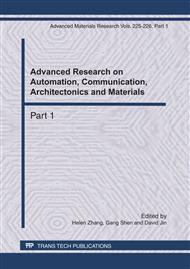[1]
G.Z. Cheng, Y.L. Pei and L.B. Chi. Method of Setting Maximum Speed Limit Based on Minimum Generalized Running Cost Of Vehicle. Journal of Jilin University. Vol. 39, No. 4 (2009), pp.900-905.
Google Scholar
[2]
G.Z. Cheng, Y.L. Pei Maximum Speed Limit on Freeway with Damaged Pavement. Journal of Southwest Jiaotong University. Vol. 43, No. 6 (2008), pp.14-717.
Google Scholar
[3]
R. Rajamani, D.N. Piyabongkarn, J.Y. Lew, K. Yi and G. Phanomchoeng. Tire-road Friction-coefficient Estimation. IEEE Control Systems Magazine. Vol. 30, No. 4 (2010), p.54–69.
DOI: 10.1109/mcs.2010.937006
Google Scholar
[4]
G. Erdogan, L. Alexander and R. Rajamani. Friction Coefficient Measurement for Autonomous Winter Road Maintenance. Vehicle System Dynamics. Vol. 47, No. 4 (2009), pp.497-512.
DOI: 10.1080/00423110802220554
Google Scholar
[5]
M. Ergun. Estimation of Friction Coefficient of Asphalt Concrete Road Surfaces Using the Fuzzy Logic Approach. Canadian Journal of Civil Engineering. Vol. 34, No. 9 (2007), pp.1110-1118.
DOI: 10.1139/l07-045
Google Scholar
[6]
T. Nakatsuji, I. Hayashi, P. Ranjitkar, T Shirakawa and A. Kawamura. Online Estimation of Friction Coefficients of Winter Road Surfaces Using the Unscented Kaiman Filter. Transportation Research Record. Vol. 2015 (2007), pp.113-122.
DOI: 10.3141/2015-13
Google Scholar
[7]
F. Holzmann, M. Bellino, R. Siegwart and H. Bubb. Predictive Estimation of the Road-tire Friction Coefficient. Proceedings of the 2006 IEEE International Conference on Control Applications. Institute of Electrical and Electronics Engineers Inc. (2007).
DOI: 10.1109/cca.2006.285964
Google Scholar
[8]
R. Rajamani, D. Piyabongkarn, J. Y. Lew and J. A. Grogg. Algorithms for Real-time Estimation of Individual Wheel Tire-road Friction Coefficients. Proceedings of the 2006 American Control Conference. Institute of Electrical and Electronics Engineers Inc. (2006).
DOI: 10.1109/acc.2006.1657460
Google Scholar
[9]
H. Makishita, K. Matsunaga. Differences of Drivers' Reaction Times According to Age and Mental Workload. Accident Analysis and Prevention. Vlo. 40, No. 2 (2008), pp.567-575.
DOI: 10.1016/j.aap.2007.08.012
Google Scholar


